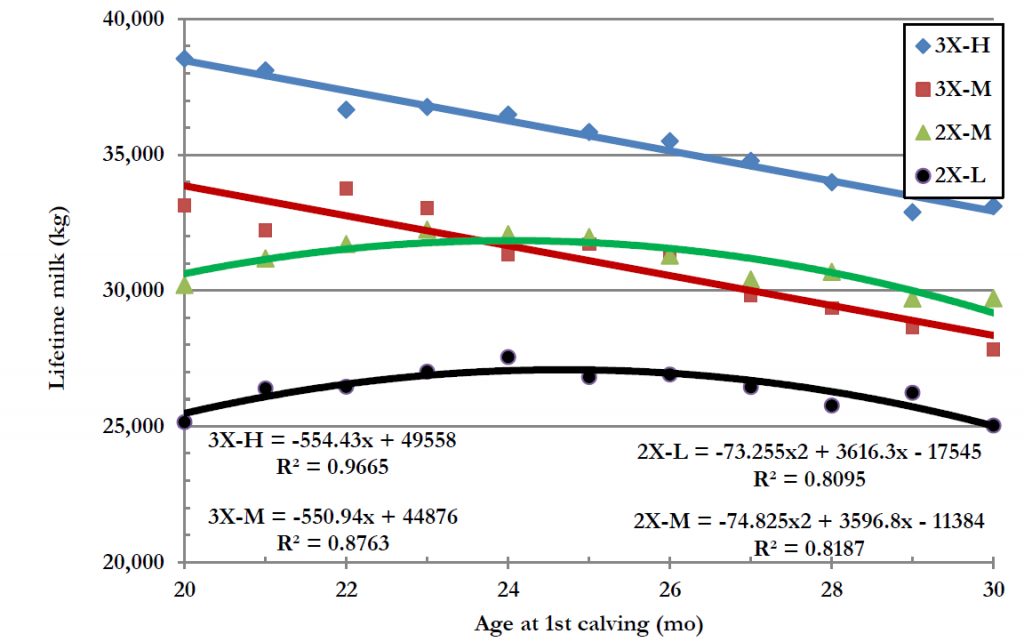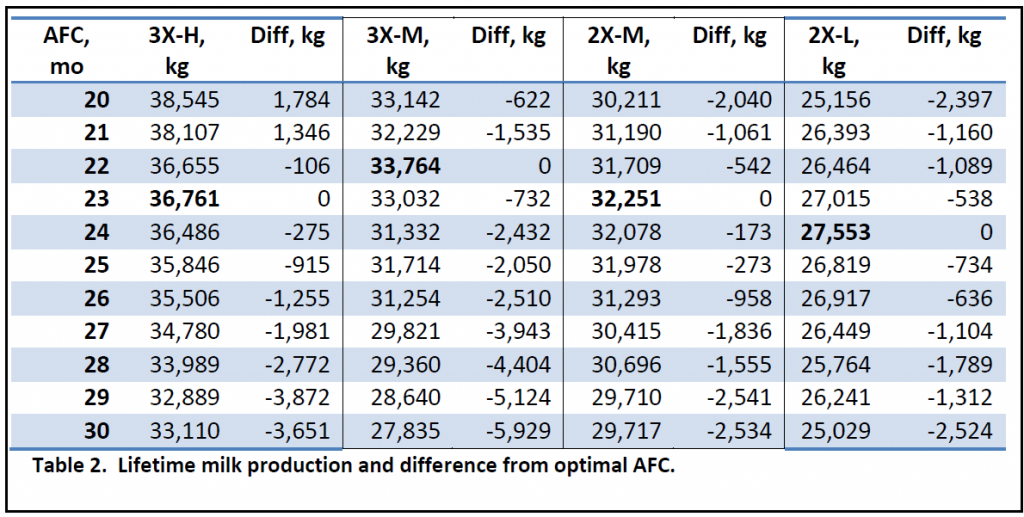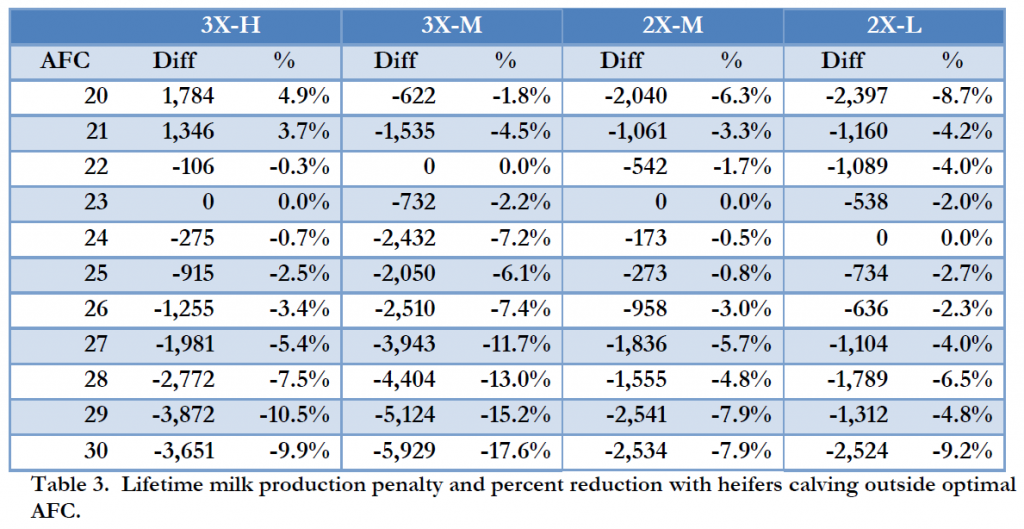Click here for a PDF version of this Calf Note
Introduction
Calves. They become heifers. Then become cows. After all, that’s the point… to raise healthy, productive animals that become part of the dairy herd. From a financial perspective, it’s important that we invest enough in our heifers for them to grow at the proper rate and enter the milking herd at the right size and age. Investing too little (particularly when it comes to feed quality and/or quantity) will slow growth and delay the age at which heifers calve. Conversely, feeding calves to grow too rapidly can result in untoward consequences, such as fat infiltration of the mammary gland, permanently impairing the heifer’s ability to make milk.

Age at first calving (AFC) has been shown to have a strong influence on a heifer’s ability to make milk. Numerous studies have reported that either first lactation or lifetime milk production can be affected when heifers calves outside of an optimum range. Table 1 contains some examples of published studies and the optimal age at first calving.
AFC and Lifetime Milk
Researchers at the University of Wisconsin reviewed DHIA records from 69,145 Holstein cows that calved in 2005 and compared the effect of AFC on first lactation and lifetime milk production. Milk production records were grouped according to 4 herd management criteria – 1) 3X milking and rolling herd average (RHA) = 12,750 kg (3X-H), 2) 3X milking and RHA = 11,250 kg (3X-M), 3) 2X milking and RHA = 11,250 kg (2X-M), and 4) 2X milking and RHA = 9,250 kg (2X-L).

When first lactation milk production was reviewed, the researchers reported a reduction of 166, 369, and 654 kg for heifers calving at 22, 21, and 20 mo, respectively, compared calving at 24 mo. There were no difference among the four production groups on 1st lactation milk production.
On the other hand, there were important differences between the four groups regarding lifetime milk production. As AFC increased in heifers in the 3X-M and 3X-H groups, there was a linear decline in lifetime milk production. Interestingly, as AFC declined to <24 mo of age, lifetime milk production continued to increase. As can be seen in Figure 1, lifetime milk production in heifers in the 3X-H and 3X-M groups (blue and red lines, respectively) continued to increase as AFC decreased, even below 24 mo of age. Heifers in the 3X-H group that calved at 20 mo of age produced about 2,000 kg more lifetime milk than heifers that calved at 24 mo of age.

Lifetime milk production was affected by AFC differently in heifers in the 2X milking groups (2X-M and 2X-L). Rather than a linear increase in lifetime milk with decreasing AFC, there was a curvilinear relationship between lifetime milk and AFC.
Heifers calving at 23 mo (2X-M) and 24 mo (2X-L) produced the most milk; any deviation from these AFC resulted in lower lifetime milk production in these two groups. As can be seen in Table 2, the difference in lifetime milk (labeled as “Diff” in Table 2) compared to the maximum ranged from +1,784 kg of lifetime milk for 3X-H herds, calving at 20 mo of age) to -5,929 kg for heifers in 3X-M herds calving at 30 mo of age.

Why did 3X vs. 2X milking affect the relationship between AFC and lifetime milk production? The authors of the study suggested that differences in longevity between heifers in 3X and 2X herds may have contributed to differences in production. Heifers in 2X herds, reducing AFC by 30 days resulted in a similar reduction (27-28 d) in herd life (heifers left the herd 27-28 d earlier) whereas in 3X herds, reducing AFC by 30 d resulted in only 13-16 d earlier. Thus heifers in 3X herds had nearly 2 weeks additional milk production days for every 30 d reduction in AFC.
Also, the terms of 3X and 2X may have been proxies for many other management practices that altered heifer management, growth, and longevity.
The Meaning of it All
The data of Curran show clearly the importance of calving at or right around 24 mo of age. Delaying calving to 26, 28 or even 30 mo of age costs money. A lot of money. Let’s consider the case of a herd that calves their heifers at an average of 28 mo of age. For the moment, we’ll ignore the additional carrying costs – feed, labor, management, capital, etc. – for the heifers. Let’s focus in on the cost of lost milk production.
For a 3X-H herd making 12,750 kg of milk per year (28,109 lb), calving at 28 mo of age would cost each heifer 2,772 kg (6,111 lb) of milk during its lifetime. If we assume that milk is worth $0.50/kg ($23/cwt) then the cost of AFC of 28 mo is 2,772 x 0.50 = $1,386 only in lost future milk production. This cost does not include the cost of additional feed, keeping additional heifers on the farm, capital, labor, etc. These costs can easily double the lost milk, so it’s quite possible that producers calving at 28 mo of age could easily lose >$2,000 per heifer when all costs are considered.
What if a herd’s milk production doesn’t coincide exactly with the averages of Curran et al.? Perhaps we can estimate changes in lifetime milk (the “penalty”) as a percentage of the mean. For example, at 26 mo AFC for the 3X-M herds, the loss in lifetime milk is 2,510 kg. Since the maximal lifetime milk for 3X-M herds was 33,764 kg (AFC = 22 mo, see Table 2 and figures in bold), the percent reduction is 2,510 / 33,764 = 7.4% reduction. You can see percent reductions from optimal in Table 3. The key will be to select the appropriate columns to identify which “percent penalty” best represents your operation.
Summary
Missing on AFC cost producers money. As can be seen in the figures in this Calf Note, it can cost a lot of money. Sometimes we can get caught up with “little” details of calf and heifer rearing and lose sight of the big picture. While other aspects of calf rearing are critical, few have the economic ramifications of inadequate (or excessive) growth and delayed (or premature) AFC. We can debate age at weaning, amount of liquid to feed in the first two months of life and the proper serum total protein to achieve at 24 h of age. However, if we do an outstanding job to weaning, but then put heifers into crowded pens and feed them inadequate amounts and concentrations of nutrients, all the investment in early calf rearing will be lost. It’s little wonder that many producers with less than optimal post-weaning management have found accelerated milk feeding systems to be an expensive investment that hasn’t paid dividends. It may not be the fault of the pre-weaning nutrition – rather, it’s post-weaning growth that is the “Achilles heel” of the program. As advisers to producers, it’s essential that we consider the entire feeding and growing program to ensure that our recommendations will address the most important economic factors on the farm.
References
Cooke, J. S., Z. Cheng, N. E. Bourne, D. C. Wathes. 2013. Association between growth rates, age at first calving and subsequent fertility, milk production and survival in Holstein-Friesian heifers. Open J. Anim. Sci. 3:1-12.
Ettema, J. F., and J. E. P. Santos. 2004. Impact of age at calving on lactation, reproduction, health, and income in first-parity Holsteins on commercial farms. J. Dairy Sci. 87:2130–2135.
Gardner, R. W., L. W. Smith, and R. L. Park. 1988. Feeding and management of dairy heifers for optimal lifetime productivity. J. Dairy Sci. 71:996-999.
Hoffman, P. C., N. M. Brehm, S. G. Price, and A. Prill-Adams. 1996. Effect of accelerated postpubertal growth and early calving on lactation performance of primiparous Holstein heifers. J. Dairy Sci. 79:2024–2031.
Nilforooshan, M.A., and M. A. Edriss. 2004. Effect of Age at First Calving on Some Productive and Longevity Traits in Iranian Holsteins of the Isfahan Province. J. Dairy Sci. 87:2130-2135.
Pirlo, G., F. Miglior, and M. Speroni. 2000. Effect of age at first calving on production traits and on difference between milk yield returns and rearing costs in Italian Holsteins. J. Dairy Sci. 83:603–608.
Teke, B. and H. Murat. 2013. Effect of age at first calving on first lactation milk yield, lifetime milk yield and lifetime in Turkish Holsteins of the Mediterranean region in Turkey. Bulg. J. Agric. Sci. 19: 1126-1129.
Van Amburgh, M. E., D. M. Galton, D. E. Bauman, R. W. Everett, D. G. Fox, L. E. Chase, and H. N. Erb. 1998. Effects of three prepubertal body growth rates on performance of Holstein heifers during first lactation. J. Dairy Sci. 81:527-538.